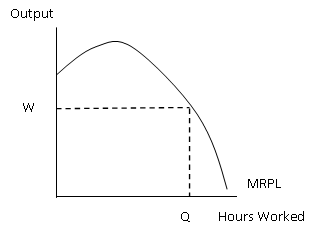When discussing factor markets we are talking about the
market for factors of production. Recall the circular flow of income (there is
a post on it somewhere) - firms are demanders of factors of production and
households are suppliers. Firms pay money to households in exchange for their
factors of production - wages for labour, for example.
We'll be looking at perfectly competitive factor markets.
Everyone in this market is a price taker, whether it be the firms, the workers or
whoever. Freedom of entry and exit exists. It costs nothing for a person to
leave the labour force and nor does it cost anything for someone to join it. We
assume that the factors are homogenous. Everyone/everything in the market has
the same level of skill and motivation. Finally, there is perfect knowledge.
Workers know everything about the firm and firms know everything about the
workers, for example.
Let us zoom in on the labour market more specifically. A
perfectly competitive labour market looks as follows:
On the left we have the market as a whole. The wage rate
is determined by the interaction of demand for workers and the supply of
workers. With this wage rate, we can
look at an individual firm on the right. At wage rate W the firm would be
willing to employ Q hours worth of labour.
We need to somehow ascertain how much labour would be
supplied by people in the labour market. This figure is dependent on many
factors. From the point of view of the worker, working involves disutility's
such as sacrificing leisure time and it being tedious/boring. The more they work the larger the disutility.
The marginal disutility of work (MDU) will increase as people work more. Due to
this, we see an upwards sloping supply curve of labour. To encourage people to
work more hours, higher wages need to be paid in order to compensate for the
higher disutility.
In general, an individual's supply of labour will look like
this. The higher the wage rate, the more hours worked. However, there is a case
where the shape of the individuals supply of labour actually bends backwards. This
is the case when an individual feels that after a certain point they can afford
to work less and have more leisure time. It looks like this:
Once wage reaches W the individual feels that they are
earning enough and can afford to cut back on the amount they work should wages
rise further.
The amount of labour a firm demands rests on the
assumptions that firms are trying t maxisimise profits. The theory is known as
the marginal productivity theory. We look at the marginal revenue product of
labour in this piece of analysis (MRPL). We know that to maximise profits, marginal
costs must equal marginal revenue, so therefore the firm will employ labour up
until the point wages (the marginal cost) equal the marginal revenue product of
labour. It looks like this:
The firm will hire Q hours worth of labour in order to
maximise their profits. What about the demand curve for a firm as a whole?
Well, because whatever the wage the firm will be producing where wages equal
MRPL, this means that the demand curve for the firm is the MRPL curve. From the
peak of the curve to the right is the demand for labour for a firm trying to
maximise its profits.
There are some firms that are known as monopsomists.
These firms are wage setters, not wage takers. They are a firm with monopoly
power on factors of production in an area - say a single employer in a village.
They have the power to restrict the amount of labour they employ to keep wage
rates down. The firm faces an upwards sloping supply curve for labour, to
employ more workers they need to pay a higher wage rate. This supply curve
shows us what wage must be paid to attract a certain amount of labour. The wage
is also the average cost of employing labour, therefore the supply curve is the
AC curve. The marginal cost of labour will be above the average costs because
to attract more employees the wage rate must be raised. The profit maximising
point for the firm would be where MCL = MRPL with a wage of W1. If we were in a
perfectly competitive market the wage rate would have been at W2 with a higher
amount of labour employed. The monopsomist forces the wage rate down by
restricting how many workers it employs.





No comments:
Post a Comment